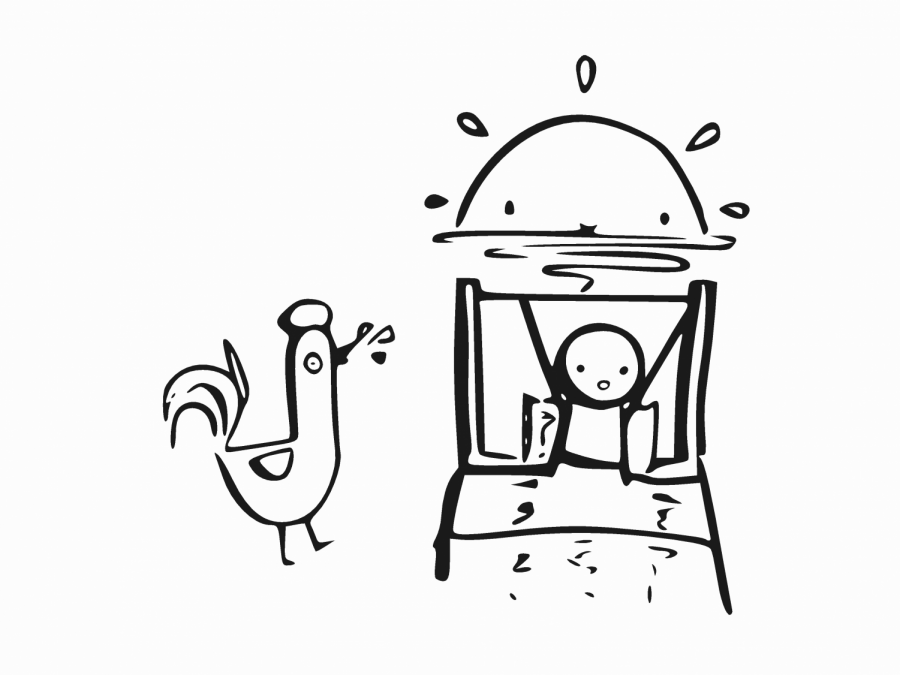Seven tips for falling asleep tonight
A good sleep schedule is integral in waking up refreshed and being the best version of yourself throughout the day.
September 3, 2018
The new school year has started already, bringing with it promises of deadlines and possibilities of sleep deprivation. As we revert from our summer schedules, it’s important to remember to still take time to relax and sleep. Apart from the usual breathing and meditation tips, here are five more to try out!
- TENSE UP! This first exercise seems counter-intuitive. Why tense up when you need to relax? Progressive muscle relaxation (PMR) ensures that your body has the least stress possible by taking away any tension you’ve built up. To perform PMR, lay down and start focusing on small muscle groups, starting from your toes. Squeeze tight for five to ten seconds while inhaling, then release and rest for ten to 20 seconds while exhaling. Make sure to cover every muscle group so that you are as relaxed as possible. Not only does this method help with falling asleep, but it also relieves general stress, anxiety and sometimes even chronic pain.
- DO BREATHING EXERCISES Breathing exercises not only decrease stress but also center your mind and replenish the oxygen levels in your blood. Try different exercises, like alternate nostril breathing, the 4-7-8 breathing pattern or simply breathing and envisioning the oxygen circulating all the way through your body before exhaling.To perform alternate nostril breathing, sit comfortably with your spine straight. Place your left hand(palm up) on your left knee. Bring your right index finger and middle fingers to rest between your eyebrows, then use your ring and pinky fingers to close your left nostril and your thumb for the right side. Exhale out of your left side, then inhale again. Press down on your left nostril with the ring finger, then release your thumb and exhale from the right. Breathe in once more from the right, close it, then exhale from the left. That completes one round of alternate nostril breathing. Continue this exercise for up to nine more rounds or until you feel relaxed. For the 4-7-8 breathing pattern, sit straight or lie down. Before you start, rest the tip of your tongue right behind your front teeth and keep it there for the entire exercise. Exhale completely through your mouth to prepare. Then, inhale through your nose for four seconds, hold your breath for seven, then exhale for eight seconds. Repeat this until you feel calm and ready to sleep. Not only does 4-7-8 breathing help with falling asleep, but it also helps with anxiety and catching your breath after strenuous exercise or tasks. However, make sure that you only use these exercises when you don’t need to be completely alert right after you do your exercises (trust me — I have experience). You’ll probably feel floaty and too relaxed to be fully aware of your surroundings.
- PRACTICE MEDITATION There are many different types of meditation you can try out before going to bed. Every night, try meditating for about five to twenty minutes to refresh your mind. Some ways to meditate include: gratitude meditation (inhale and think of something you’re thankful for, then exhale and say “thank you” out loud – this also helps when you’re angry at something!), emptying your mind (envision putting all your thoughts into a little box and sending them away, then focus on the nothingness) and focusing in on what your body is doing (start from either the head or the toes, and concentrate on every little movement). Like breathing exercises, there are many different ways of meditating. While the examples provided here are the most helpful personally, you may find that something else works better for you. Don’t hesitate to search it up! Just not right before you need to sleep.
- KEEP A DAILY JOURNAL Log your day to clear your mind before going to bed. Happy or sad, sharing something or writing something down always helps release the emotion. It’s also a good idea to track how your day was and keep track of all your moods. This will also make you more aware of how you’re doing every day and how you might be able to improve your daily life.
- MAKE A TO-DO LIST Creating a to-do list aims to take any intruding thoughts off your mind. High stress levels are never positive, especially when you really need to rest up for a busy day. Creating a to-do list and schedule for tomorrow is a great way to release some of that anxiety about not being able to finish all your tasks in time. Not only will you have everything you need to do in order, but you’ll also know when exactly you will have time to do them and when they will be completed.
- NO-SCREEN TIME Try staying away from bright screens like phones, TVs and computers at least 30 minutes before bedtime. Our brains are wired to start producing melatonin, the sleep hormone, when the sun sets, or when there’s less blue light and overall light around. Staring at a bright screen impedes the hormone production and makes it harder to fall asleep. Additionally, even if spending some free time on an electronic device seems like a good way to unwind before sleeping, it keeps your brain alert to what’s going on in your social media feed or your favorite movie.
- CREATE A BEDTIME ROUTINE This last tip is more of a long-term solution. By creating a bedtime routine, you train your body to recognize when you are about to head off to dreamland. First, start off easy, then build up your routine! For example, your first few days might just include no-screen time, brushing your teeth and PMR, all in the same order, every single day. Slowly build up your routine until you find one plan that works the best for you. Constantly practicing the pattern will allow your body to associate these steps with going to bed and allow you to fall asleep more easily.
This piece was originally published in the pages of The Winged Post on Aug. 31, 2018.


















![“[Building nerf blasters] became this outlet of creativity for me that hasn't been matched by anything else. The process [of] making a build complete to your desire is such a painstakingly difficult process, but I've had to learn from [the skills needed from] soldering to proper painting. There's so many different options for everything, if you think about it, it exists. The best part is [that] if it doesn't exist, you can build it yourself," Ishaan Parate said.](https://harkeraquila.com/wp-content/uploads/2022/08/DSC_8149-900x604.jpg)




![“When I came into high school, I was ready to be a follower. But DECA was a game changer for me. It helped me overcome my fear of public speaking, and it's played such a major role in who I've become today. To be able to successfully lead a chapter of 150 students, an officer team and be one of the upperclassmen I once really admired is something I'm [really] proud of,” Anvitha Tummala ('21) said.](https://harkeraquila.com/wp-content/uploads/2021/07/Screen-Shot-2021-07-25-at-9.50.05-AM-900x594.png)







![“I think getting up in the morning and having a sense of purpose [is exciting]. I think without a certain amount of drive, life is kind of obsolete and mundane, and I think having that every single day is what makes each day unique and kind of makes life exciting,” Neymika Jain (12) said.](https://harkeraquila.com/wp-content/uploads/2017/06/Screen-Shot-2017-06-03-at-4.54.16-PM.png)








![“My slogan is ‘slow feet, don’t eat, and I’m hungry.’ You need to run fast to get where you are–you aren't going to get those championships if you aren't fast,” Angel Cervantes (12) said. “I want to do well in school on my tests and in track and win championships for my team. I live by that, [and] I can do that anywhere: in the classroom or on the field.”](https://harkeraquila.com/wp-content/uploads/2018/06/DSC5146-900x601.jpg)
![“[Volleyball has] taught me how to fall correctly, and another thing it taught is that you don’t have to be the best at something to be good at it. If you just hit the ball in a smart way, then it still scores points and you’re good at it. You could be a background player and still make a much bigger impact on the team than you would think,” Anya Gert (’20) said.](https://harkeraquila.com/wp-content/uploads/2020/06/AnnaGert_JinTuan_HoHPhotoEdited-600x900.jpeg)

![“I'm not nearly there yet, but [my confidence has] definitely been getting better since I was pretty shy and timid coming into Harker my freshman year. I know that there's a lot of people that are really confident in what they do, and I really admire them. Everyone's so driven and that has really pushed me to kind of try to find my own place in high school and be more confident,” Alyssa Huang (’20) said.](https://harkeraquila.com/wp-content/uploads/2020/06/AlyssaHuang_EmilyChen_HoHPhoto-900x749.jpeg)












Bennett Liu • Aug 10, 2019 at 1:24 am
Great article! I have especially found that keeping a log helps to bring closure to the day and a feeling of accomplishment before going to sleep, which can help reduce stress.